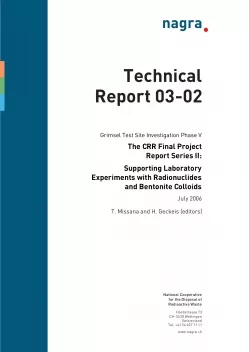
Technical Report NTB 03-02
Grimsel Test SiteInvestigation Phase VThe CRR Final Project Report Series II: Supporting Laboratory Experiments with Radionuclides and Bentonite Colloids
A series of laboratory experiments was carried out in support of the in situ programme and of the modelling studies of the 'Colloid and Radionuclide Retardation Project' (CRR) at Nagra’s Grimsel Test Site (GTS). The aim of those experiments was to study the geochemical interaction of radionuclides in the system Grimsel groundwater – granodiorite / fracture filling material – bentonite and to provide the necessary data for the final planning of the in situ migration experiments. The laboratory studies showed that:
- the chemistry of the Grimsel groundwater favours the stabilization of aquatic colloids, specifically of colloidal smectite particles derived from bentonite barrier material. A concentration of 20 mg L-1 was shown to provide enough sorption sites to bind all the radionuclides which would be injected at the CRR field experiment
- colloids can considerably influence the transportation of the actinides U, Pu and Am and the fission product Cs (distribution of radionuclides between the aqueous and solid phases in presence and absence of colloids). For 75Se(IV), 99Tc(VII) and Np(V) the influence of colloids appears to be of less importance
- the sorption reactions of Cs, U, Pu and Am are characterized by slow kinetics – sorption (or other uptake) reaction onto granodiorite and fracture filling does not appear to reach equilibrium on a timescale of weeks
- the extent of uptake of Cs, U and, in particular Pu and Am onto fracture filling or granodiorite decreases in the presence of smectite colloids
- there are clear indications of, at least, partial reversibility for Pu and Am
Distribution coefficients (Rd) were determined for the main elements considered in the in situ experiment for the three main solids, namely, bentonite colloids, granodiorite and fracture filling material. Sorption isotherms have been determined for U, Sr and Cs, in order to illustrate the concentration dependency of the sorption of these elements. The experimental observations made in this work with regard to colloid formation and sorption kinetics of Pu and Am give an indication of the complexity of uptake processes in this multi-phase system. Because the residence times of the radionuclides and colloids in the CRR experimental site are many orders of magnitude shorter than expected in a repository, additional processes, such as sorption kinetics, which may be of little relevance to an actual repository, needed to be considered for the design and interpretation of the in situ experiment.
